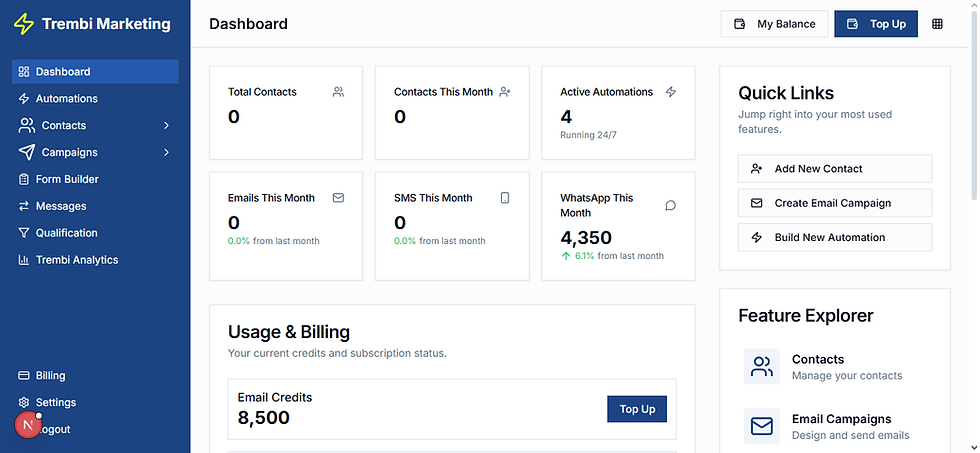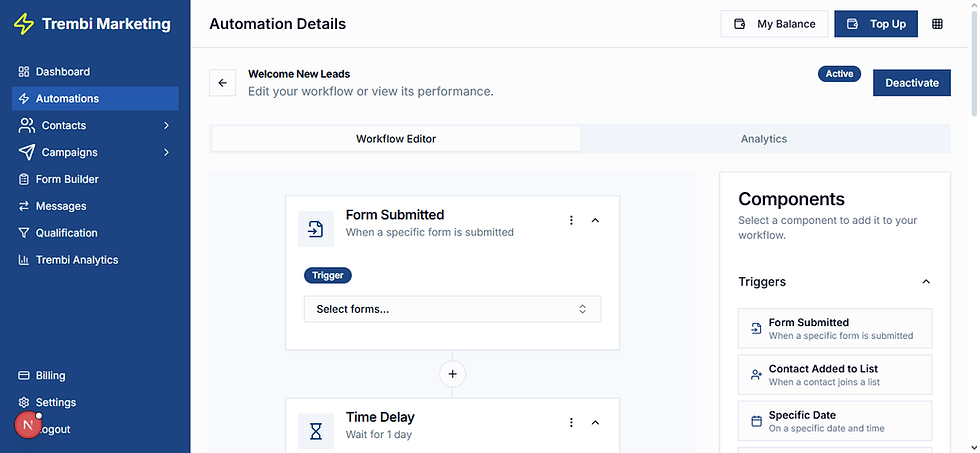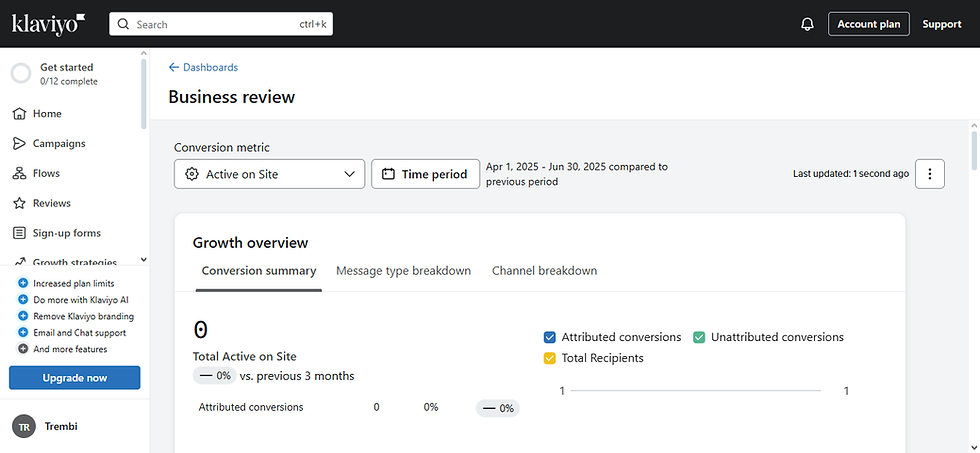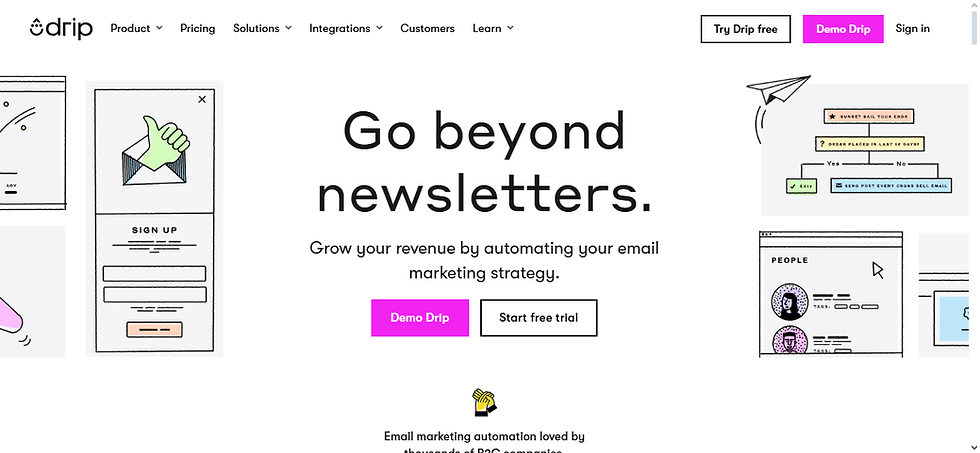10 Best ActiveCampaign Alternatives
- Ntende Kenneth
- Jul 30, 2025
- 11 min read
Updated: Aug 5, 2025
If you're considering switching from ActiveCampaign, you're not alone. While it's a solid platform, it gets expensive fast and can be overwhelming for small businesses and startups. The good news? There are plenty of tools offering better pricing, simpler setups, or more tailored features.
Here’s a quick comparison of the top 10 ActiveCampaign alternatives:
Prefer to watch a video:
Tool | Best For | Free Plan | Starting Price | G2 Rating |
Trembi Marketing | Complete marketing ecosystem | Yes – Forever Free | $0/month (Free Plan) | 4.7 |
Brevo | Bulk email, SMS & CRM | Yes | $9/month | 4.5 |
Mailchimp | Beginners, small businesses | Yes | $13/month | 4.3 |
Klaviyo | Ecommerce personalization | Yes | $20/month | 4.6 |
ConvertKit | Creator monetization | Yes | $9/month | 4.3 |
AWeber | Small ecommerce automation | Yes | $12.50/month | 4.2 |
Drip | Advanced ecommerce workflows | 14-day Trial | $39/month | 4.4 |
MailerLite | Simple automation & design | Yes | $9/month | 4.7 |
GetResponse | All-in-one marketing suite | Yes | $19/month | 4.2 |
Campaign Monitor | Agency client management | Free trial | $9/month | 4.1 |

1. Trembi Marketing: The Complete Sales & Marketing Ecosystem
Trembi Marketing is part of the larger Trembi Sales and Marketing ecosystem. That means you're not just getting email marketing you're gaining access to a suite of tools designed to help you find, convert, and retain customers under one roof.
With seamless integration into Trembi Sales (CRM + Sales Automation), Trembi Ads (paid ads), Trembi Commerce (landing pages and mini sites), and Trembi Connect (influencer marketing), you can run full-funnel campaigns without needing multiple tools.

Why Trembi Stands Out
Free forever plan with unlimited contacts and up to 3,000 emails/month
WhatsApp, SMS & Email marketing in one platform
Clean drag-and-drop campaign builder for multi-channel outreach
CRM and AI automation built in for lead nurturing and customer retention
Part of the Trembi ecosystem, giving you tools for sales, ecommerce, ads, and influencer marketing all connected
Pricing
Free forever plan: unlimited contacts, 3,000 emails/month
Best for: Growing teams and small businesses that want an all-in-one platform to handle everything from lead generation to conversion

2. Brevo: The High-Volume Workhorse
Brevo (formerly Sendinblue) built their reputation on one thing: handling massive email volumes without breaking your budget or your server.
What makes it a great option:
Industrial-strength infrastructure: While other platforms crash during Black Friday, Brevo processes billions of emails monthly. Their delivery rates stay consistent even when you're sending 100,000+ emails per campaign.
Advanced segmentation for complex businesses: Create segments based on purchase history, email engagement, website behavior, and custom events. Then layer on demographic data, geographic filters, and time-based triggers. It's powerful enough for enterprise teams but simple enough for small businesses.
Transactional email that actually delivers: Your order confirmations, password resets, and shipping notifications get priority delivery. Separate infrastructure from marketing emails means higher deliverability rates.
SMS marketing with global reach: Send SMS to 190+ countries with local number support. Automated SMS sequences work just like email automations. Great for time-sensitive offers or urgent notifications.
Marketing automation with logic branches: Build complex workflows with if/then logic, wait conditions, and split testing. Someone opens your email but doesn't click? Send them a different message. Someone clicks but doesn't buy? Add them to a nurture sequence.
CRM functionality for sales teams: Track deals, manage contacts, and automate follow-ups. Sales reps can see complete email history, website visits, and engagement data for every lead.

The downsides to know: Interface feels dated compared to newer platforms. Learning curve is steeper for beginners. Advanced features require higher-tier plans.
Pricing breakdown:
Free: 300 emails daily (9,000/month), unlimited contacts
Starter: $9/month for 5,000 emails
Business: $18/month for 10,000 emails plus advanced features
Enterprise: Custom pricing for 100,000+ emails
Best fit: Companies sending 25,000+ emails monthly and teams that prioritize deliverability over design.
3. Mailchimp: The Gateway Drug
Mailchimp gets people started, then they outgrow it. That's not necessarily bad - sometimes you need training wheels.
Why thousands of business use this:
Templates that don't embarrass you: Pre-designed emails that look professional out of the box. Drag-and-drop editor that actually works. Even design-challenged founders can create decent campaigns.
Automations for beginners: Pre-built sequences for welcome emails, abandoned carts, and customer win-back campaigns. You just turn them on and customize the copy.
Integrations: Connects to 300+ tools including Shopify, WordPress, QuickBooks, and Salesforce. Setup is usually one-click.
Audience insights that teach you: Reports show not just opens and clicks, but subscriber growth trends, best send times, and engagement patterns. Good for learning email marketing fundamentals.
Landing pages and signup forms: Create lead magnets and opt-in forms without needing a separate tool. Forms integrate automatically with your email lists.
Where it falls short:
Automation is basic compared to dedicated platforms.
Advanced segmentation costs extra.
Customer support is hit-or-miss.
Pricing jumps quickly as you grow.
The real costs:
Free: 1,000 emails monthly, 500 contacts
Essentials: $13/month for 5,000 contacts
Standard: $20/month with automations
Premium: $350/month for advanced features
Perfect for: New businesses, solopreneurs, anyone who needs something simple that works immediately.

4. Klaviyo: The Ecommerce Revenue Machine
Klaviyo doesn't just send emails - it makes you money. Built specifically for online stores, every feature connects to your bottom line.
Features:
Predictive analytics that work: Klaviyo calculates customer lifetime value, predicts when customers will churn, and identifies your most valuable segments. Use this data to personalize campaigns and prioritize high-value customers.
Dynamic product recommendations: Emails automatically include products based on browsing history, purchase patterns, and similar customer behavior. Someone who bought running shoes gets recommendations for athletic wear, not kitchen appliances.
Advanced customer segmentation: Create segments like "customers who spent $200+ in the last 30 days but haven't purchased in 14 days" or "subscribers who viewed your product page 3+ times but never bought." Precision targeting that directly impacts sales.
Cross-channel attribution: Track revenue from email, SMS, and social media campaigns in one dashboard. See which channels drive the most valuable customers, not just the most clicks.
Behavioral trigger campaigns: Automated sequences based on specific actions: abandoned cart, browsed but didn't buy, first purchase anniversary, or VIP customer milestone. Each trigger can launch different campaigns across email and SMS.
Deep ecommerce integrations: Syncs product catalogs, inventory levels, order data, and customer profiles from Shopify, Magento, WooCommerce, and BigCommerce. Real-time data means accurate recommendations and timely campaigns.
SMS marketing that converts: SMS campaigns use the same customer data as email. Coordinate messaging across channels or use SMS for urgent, time-sensitive offers.
Why ecommerce teams choose it:
Average Klaviyo user sees 30-40% of their revenue attributed to email marketing. Compare that to 15-20% for generic platforms.
Investment levels:
Email: $20/month for 251-500 contacts
Email & SMS: $35/month for 251-500 contacts
Pricing scales with contact count and email volume
Ideal for: Online stores doing $50K+ annual revenue, subscription businesses, brands with repeat customers.

5. ConvertKit: The Creator Economy Champion
ConvertKit understands creators differently. While other platforms focus on businesses selling products, ConvertKit helps people monetize their audience.
Creator-specific features:
Visual automation builder: Design email sequences that match how creators think. Instead of complex flowcharts, you get visual rules like "if someone downloads my free guide, send them my course promotion in 3 days."
Subscriber tagging system: Tag subscribers based on interests, purchase history, or engagement level. Someone interested in photography gets different content than someone interested in business. Tags help you send relevant content consistently.
Landing page builder for lead magnets: Create opt-in pages for free courses, ebooks, templates, or exclusive content. Pages are optimized for conversions and mobile-friendly by default.
Digital product sales: Sell courses, ebooks, coaching calls, or digital downloads directly through ConvertKit. Payment processing, delivery, and customer management all handled automatically.
Segmentation for content creators: Identify your most engaged subscribers, new followers, paying customers, and inactive contacts. Send different content to each group to maximize engagement and sales.
Creator reports that matter: Track subscriber growth, content performance, and revenue attribution. See which lead magnets attract the best customers and which emails drive the most sales.
Integrations with creator tools: Connects to course platforms like Teachable and Thinkific, payment processors like Stripe and PayPal, and content platforms like WordPress and Ghost.
Why creators stick with it: Interface designed for people who create content, not corporate marketers. Features focus on building relationships and monetizing expertise, not just sending newsletters.
The creator pricing model:
Free: 1,000 subscribers, basic features
Creator: $9/month for up to 300 subscribers
Creator Pro: $25/month with advanced features
Pricing increases with subscriber count
Perfect for: Bloggers, YouTubers, podcasters, course creators, coaches, consultants.
6. AWeber: The Reliable Workhorse
AWeber has been around since 1998. They've seen every email marketing trend come and go. What remains is a platform that just works.
Dependable features:
AMP emails for Gmail: Your emails can include working buttons, forms, and interactive elements that function directly in Gmail. Subscribers can complete actions without leaving their inbox.
Autoresponder sequences: Set up email series that send automatically based on signup date. Perfect for onboarding new customers or nurturing leads over time.
Sign-up form variety: Pop-ups, inline forms, floating bars, and landing pages. Forms can be embedded anywhere and automatically sync with your email lists.
List management tools: Import contacts, remove duplicates, manage unsubscribes, and segment lists based on engagement or demographics.
Email deliverability focus: AWeber maintains relationships with major ISPs to ensure your emails reach inboxes. They provide tools to improve sender reputation and avoid spam filters.
Customer support that responds: Phone, chat, and email support with real humans. Extensive knowledge base and video tutorials for DIY learners.
Integration ecosystem: Connects to major ecommerce platforms, CRM systems, and business tools. Not as extensive as some competitors but covers the essentials.
Where it shows its age: Interface feels dated compared to newer platforms. Automation capabilities are basic. Limited advanced segmentation options.
Straightforward pricing:
Free: 500 subscribers, 3,000 emails monthly
Pro: $12.50/month for up to 500 subscribers
Pricing scales with subscriber count
Right choice for: Small businesses that want reliability over flashy features, companies focused on email deliverability, teams that prefer phone support.
7. Drip: The Ecommerce Automation Expert
Drip calls itself "ECRM" - Ecommerce CRM. They built everything around the idea that ecommerce marketing is fundamentally different from other marketing.
Ecommerce-first approach:
Customer lifecycle automation: Pre-built workflows for every stage of the customer journey: welcome series, product education, purchase follow-up, win-back campaigns, and loyalty programs.
Revenue-per-recipient tracking: See exactly how much money each email campaign generates. Track revenue per subscriber, average order value, and customer lifetime value.
Advanced product recommendations: Machine learning analyzes purchase patterns to suggest products customers actually want. Recommendations get better over time as more data is collected.
Cart abandonment sophistication: Multi-step abandoned cart sequences that include product images, customer reviews, and limited-time discounts. Recovery rates typically 15-20% higher than basic platforms.
Customer win-back campaigns: Identify customers who haven't purchased recently and automatically send targeted offers to re-engage them. Campaigns adapt based on purchase history and preferences.
Shopify integration depth: Syncs customer data, order history, product catalogs, and inventory levels in real-time. Campaigns can include live inventory counts and personalized product feeds.
Behavioral event tracking: Track custom events like "viewed product," "added to cart," "started checkout," or "downloaded app." Use these events to trigger specific email sequences.
Multi-channel orchestration: Coordinate email campaigns with Facebook ads, Google ads, and other channels. Ensure consistent messaging across all touchpoints.
The learning curve: Drip is powerful but complex. Expect a few weeks to fully understand all features. Advanced workflows require strategic thinking, not just technical setup.
Investment required:
14-day free trial
Basic: $39/month for up to 2,500 contacts
Pro: $89/month with advanced features
Enterprise: Custom pricing for large stores
Best suited for: Established ecommerce brands, Shopify stores doing $100K+ annually, companies with dedicated marketing teams.

8. MailerLite: The Elegant Simplicity Choice
MailerLite proves that powerful doesn't have to mean complicated. They focus on essential features executed perfectly.
Streamlined excellence:
Intuitive drag-and-drop editor: Create beautiful emails without design skills. Templates are modern and mobile-optimized. Editing feels natural, not frustrating.
Automation workflows: Visual automation builder for complex sequences. Trigger campaigns based on subscriber behavior, dates, or custom events.
Advanced segmentation: Create segments based on location, behavior, custom fields, or engagement levels. Use segments to personalize campaigns and improve relevance.
Landing page builder: Create lead capture pages, thank you pages, and promotional pages. Built-in A/B testing helps optimize conversion rates.
Pop-up and embedded forms: Smart forms that can be triggered by time, scroll percentage, or exit intent. Forms integrate seamlessly with automation workflows.
Detailed reporting: Track opens, clicks, unsubscribes, and revenue. Heat maps show which parts of your emails get the most attention.
Website builder included: Create simple websites and blogs directly in MailerLite. Good for businesses that don't need complex websites but want something professional.
What you won't get: Advanced CRM features, extensive third-party integrations, or complex automation logic. MailerLite keeps things simple by design.
Honest pricing:
Free: 1,000 subscribers, 12,000 emails monthly
Growing Business: $9/month for up to 1,000 subscribers
Advanced: $18/month with additional features
Enterprise: Custom pricing for 100,000+ subscribers
Perfect match for: Freelancers, content creators, small businesses that want professional results without complexity.

9. GetResponse: The Swiss Army Knife
GetResponse tries to be everything to everyone. Sometimes that works, sometimes it doesn't. But for businesses that want one tool for everything, it's worth considering.
The complete toolkit:
Email marketing foundation: Responsive email templates, drag-and-drop editor, A/B testing, and delivery optimization. Solid basics that work reliably.
Marketing automation: Visual workflow builder for complex automation sequences. Trigger emails based on website visits, purchase behavior, or engagement patterns.
Landing page builder: Create high-converting landing pages with built-in templates. A/B test different versions and track conversion rates.
Webinar hosting platform: Host live webinars, automated webinars, and on-demand presentations. Integrate webinar attendance with email campaigns.
Sales funnel builder: Create complete sales funnels from awareness to purchase. Include landing pages, email sequences, and payment processing.
Live chat functionality: Add chat widgets to your website and manage conversations from GetResponse. Chat history integrates with email marketing data.
Ecommerce features: Product recommendation engine, abandoned cart recovery, and purchase-based segmentation. Not as advanced as dedicated ecommerce platforms but covers the basics.
Social media ads: Create and manage Facebook ads directly from GetResponse. Sync email subscriber data with ad targeting.
The jack-of-all-trades problem: Each feature is decent but not exceptional. Dedicated tools often perform better for specific functions.
Value-focused pricing:
Free: 500 contacts, basic features
Email Marketing: $19/month for 1,000 contacts
Marketing Automation: $59/month with automation and landing pages
Ecommerce Marketing: $119/month with advanced features
Good choice for: Small businesses that want one platform for everything, marketers on tight budgets, companies that prefer simplicity over specialization.
10. Campaign Monitor: The Agency Professional
Campaign Monitor built their platform specifically for agencies and consultants managing multiple client campaigns.
Agency-focused features:
Client management system: Separate workspaces for each client with individual branding, templates, and reporting. Easily switch between clients without mixing up campaigns.
White-label options: Remove Campaign Monitor branding and add your own. Clients see your brand throughout the entire email marketing experience.
Collaboration tools: Multiple team members can work on campaigns with different permission levels. Approve campaigns before they send, comment on drafts, and track changes.
Template marketplace: Professional email templates designed by experts. Templates are categorized by industry and campaign type.
Advanced segmentation: Create complex subscriber segments based on behavior, demographics, and custom data. Use segments across multiple clients while keeping data separate.
Detailed analytics: Campaign performance reports, subscriber engagement tracking, and ROI measurement. White-label reports you can share directly with clients.
API and integrations: Robust API for custom integrations. Connects to major CRM systems, ecommerce platforms, and business tools.
Deliverability expertise: Campaign Monitor maintains strong relationships with ISPs and provides tools to improve inbox placement rates.
The agency tax: Features are solid but pricing is higher than competitors. You're paying for agency-specific functionality.
Professional pricing:
Basic: $9/month for 500 contacts
Unlimited: $29/month for 500 contacts with advanced features
Premier: $149/month with priority support and advanced features
Custom pricing for larger agencies
Designed for: Marketing agencies, consultants, freelancers managing multiple clients, businesses that need white-label solutions.
Making the Switch: What Actually Matters
After testing dozens of platforms, here's what really determines success:
Start with your biggest pain point:
Paying too much? Try Trembi Marketing, MailerLite or Brevo
Too many disconnected tools? Consider Trembi Marketing
Low email deliverability? Look at AWeber or Campaign Monitor
Need better ecommerce features? Test Klaviyo or Drip
Want simpler automation? Try ConvertKit or GetResponse
Migration reality check: Most platforms will import your contacts and basic data. But you'll need to rebuild automations, recreate templates, and retrain your team. Budget 2-3 weeks for a complete transition.
The hidden costs everyone ignores:
Training time for your team
Template redesign work
Integration setup with other tools
Potential deliverability issues during transition
Testing time to ensure everything works
Questions to ask during trials:
How long does it take to create a basic email campaign?
Can you easily find engaged vs. unengaged subscribers?
Do automations work reliably without manual intervention?
How quickly does customer support respond?
What happens to your data if you want to leave?
The 30-day test plan:
Week 1: Import data and send basic campaigns
Week 2: Set up one automation sequence
Week 3: Create segments and test advanced features
Week 4: Analyze results and compare to previous platform
Red flags to watch for:
Setup takes longer than promised
Customer support doesn't respond within 24 hours
Features don't work as demonstrated
Hidden fees appear after signup
Data export options are limited
The truth about switching: Most businesses see a temporary dip in performance during transitions. Plan for this. Your first month will likely have lower engagement as you learn the new system and subscribers adjust to changes.
But companies that switch thoughtfully usually see better results within 60 days. Lower costs, better features, and improved workflows make the temporary hassle worthwhile.
The best email marketing platform is the one your team will actually use consistently. Pick based on your real needs, not feature lists or marketing promises.
.jpg)



Comments